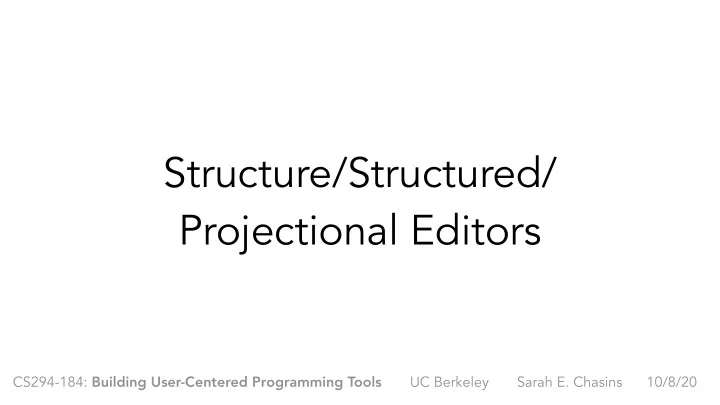

Structure/Structured/ Projectional Editors CS294-184: Building User-Centered Programming Tools UC Berkeley Sarah E. Chasins 10/8/20
Reading Reflection Discuss in groups • What do you think is the difference between a visual editor and a projectional editor (if any)? • Based on the readings for today, come up with: • 3 task-audience combinations for which you’d instantiate a language in a non-projectional editor • 3 task-audience combinations for which you’d instantiate a language in a projectional editor
structure editor == structured editor == projectional editor
What’s happening inside my compiler? code generator parser fun square arg int return num int × num num Assembly Language Compiler
What’s happening inside my compiler? code generator parser WHAT’S ALL THIS?? fun square arg int return num int × num num Assembly Language Compiler
What’s happening inside my compiler? AST code generator parser fun square arg int return num int × num num Assembly Language Compiler
Abstract Syntax Tree (AST) Abstract because we’re not putting in every detail of AST the actual programming language syntax. (E.g., we’ve dropped all those pesky semicolons and parens.) fun Syntax because we’re representing the syntactic square arg int return structure of the code in question. num int × Tree because…well, obvious. But look, we got to num num throw away a bunch of parens and other grouping things because it’s all in the tree structure now! Compiler
Abstract Syntax Tree (AST) AST Programs are data! We can mess with them! fun …and we can build them up directly. We don’t square arg int return have to write in a textual programming language and use a parser to recover this num int × structure. num num Compiler
Projectional Editor An editor where you’re building up the AST directly. People can argue about the meaning of “directly.” How far does it have to be from the actual AST before it stops being a projectional editor? But basically it’s just a judgment call.
Projectional isn’t a feature of the programming language It’s a feature of the programming environment ! Basically, it’s a matter of what editor we’re using to build up programs in the language.
Python
…also Python
Programming Language vs. Programming Environment Both of those were Python—same language. One editor was clearly textual, and one editor was clearly visual. One editor was (probably) non-projectional, and one editor was clearly projectional.
Programming Language vs. Programming Environment Programming Language: For our purposes today, a code generator that takes ASTs as input Programming Environment: The tool or tools we use for building up those ASTs
Programming Language vs. Programming Environment Why do people get this confused? Probably just because there are some visual languages that have only one interpreter, their own custom visual editor. If no one has written a parser for a text-based version of a given language, a visual environment may be the only way to write programs in it.
Programming Language vs. Programming Environment Examples Snap! : Both a programming language and a paired programming environment Scratch : Same deal, both a programming language and a paired programming environment Blockly : A library for making programming environments for whatever language you want
Projectional Editor vs. Visual Editor Projectional Editor : Any editor (can be textual or visual) in which we build up programs by interacting directly with ASTs Visual Editor : Any editor (can be projectional or non- projectional) in which we build programs by any means other than typing text in a textbox
Visual but not projectional https://bubble.io/ build and run web applications without code
Visual but not projectional Stagecast Creator TM allows adults and children as young as 8 to build their own simulations and games
Non-Projectional Projectional Textual + paredit Visual
Snap! Activity https://snap.berkeley.edu/snap/snap.html
Snap! Activity - Stage 1
Snap! Activity - Stage 2
Snap! Activity - Stage 3
Snap! Activity - Stage 4 HW Assignment 6 http://schasins.com/cs294-usable-programming-2020/assets/assignments/a6.pdf Note: Doesn’t have to be in Snap!
Goal for next reading • Prepare to write a program slicer! Understand the basics in preparation for writing your own.
Recommend
More recommend